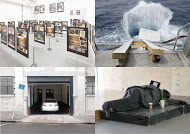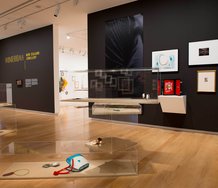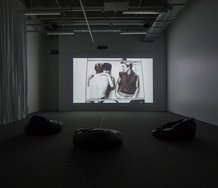Emma Jameson – 27 August, 2014
The Walters Prize nominations are undeniably exciting in their challenging of what is traditionally perceived to be ‘art' within the public sphere, but this excitement begs the question: can a cultural, artistic critique ever extend beyond the sensationalised to become substantially ingrained within the mental fabric of society?
Auckland
Denny, Leach, Thompson, ‘Uhila
The Walters Prize
12 July -12 October 2014
The socially conscious nature of the nominations for the Walters Prize this year has generated a lot of excitement and debate. Maddie Leach, Simon Denny, Luke Willis Thompson and Kalisolaite ‘Uhila engage with issues concerning the environment, technological development and social and economic inequality through performative pieces and conceptual installations that seem to decidedly diverge from the traditional frame of the gallery institution. The status quo is challenged through the form and content of the nominations and this seems to have prompted the arts sphere to excitedly re-ask the question: maybe art can cause a revolution of societal perception and awareness? Perhaps we finally have moved beyond the stagnancy caused by a pandering to the commercial properties inherent in the art-work and institution? Have we rediscovered the essence of a truly revolutionary art form that is controversial in its ability to challenge, critique and provoke?
The very nature by which we experience the nominations for the Walters Prize signals a departure from the connotations of institution embodied within the gallery space. The nominations for the Walters Prize are refreshing in the active agency that they require from the audience. We can not simply stand in front of a painting or a photograph and make mental notes of colour and form, but are rather required to use the power of the imagination to construct the art experience for ourselves. The nominations are unashamedly demanding of the viewer - the onus is on us to see what can’t be seen, and construct what is left enigmatically unconstructed.
The taxi ride and walk around the house in Thompson’s inthisholeonthisislandwhereiam requires the us to embark on a physical and conceptual journey, the purpose of which is left for us to decide and analyse. With no narrative provided by wall-texts, we are left to walk around the house, the hairs on the back of our necks prickling with anticipation at the prospect of discovering something that will provide us with concrete meaning. The house is an open field into which we can project our prejudices, thoughts, fears, and concerns to construct our own narrative. Even though I had prior knowledge of Thompson’s project, I found my imagination working overload to construct a point of mental orientation for myself. I asked myself questions that ranged from the imaginative to the more mundane: is Thompson’s mother allowed to move objects within the house throughout the duration of the prize? How many people live here? What family events have taken place here? Such questions reverberated within me afterwards and the inconclusive mental state with which I left the house still preoccupies me.
Kalisolaite ‘Uhila’s Mo’ui tukuhausia also presents questions that I still haven’t quite answered. As stated by the pamphlet about the Walters Prize 2014, ‘Uhila’s piece explores “art’s capacity to enact change within a given place”. Indeed, by sleeping rough on the streets of Auckland he re-asserts the socio-critical role that art can assume in a society in which the gap between the rich and poor seems to be ever increasing (an estimated 15,000 people are sleeping rough on the streets of Auckland [1]). By centring his ‘performance’ on the act of being homeless, it could be said that ‘Uhila prompts us to be an engaged audience for not just his work, but also for the rest of the homeless population in New Zealand. He was so shocked by his experience at Te Tuhi in the initial iteration of this work (during which time he was spat and sworn at), that he wants to be a ‘voice for the voiceless’[2]. Through observing his plight we are given a personal identity with whom we can identify, challenging our misconceptions about homeless people and their personal backgrounds.
His art performance has certainly generated a lot of public interest, with Campbell Live utilising an interview with the artist as a springboard from which to focus on the issue of homelessness in Auckland. The Walters Prize then becomes not just a stage on which to showcase the artist, but a platform through which easily brushed aside social issues are made uncomfortably public in nature. The institution of the art gallery is utilised to critique the institutional foundations upon which it is built, namely class and commercial elitism. The concern for the social, rather than the commercial, is made explicit through the artist’s donation of the per diem artist funds to the Auckland City Mission.
Yet I do question the effectiveness of what Handscomb terms ‘Uhila’s “plight of the homeless”. ‘Uhila’s “performance” of the homeless lifestyle has certainly provided him with an undeniable empathy and understanding of how homeless people live on a daily basis in Auckland. His nomination for the Walters Prize is, however, a temporary choice of life style - although admirable, it is something that he can opt out of in October. To state the obvious, homeless people do not have this option. Generally, they suffer from profound financial and sometimes mental disabilities that have locked them into a cycle from which it is very difficult to escape. It is this aspect of the work that makes the cynical side of me rear up, poised to launch a critique. ‘Uhila opting in and out of a situation that he has control over seems to be a slap in the face for the large majority of people who live in daily poverty without getting a condescending pat on the back for enduring their ‘extreme’ living conditions. When appreciating his work then, do we merely become voyeurs instead of social activists, comfortably commending an artist for entering unknown territory without facing any sense of social responsibility?
Granted, my issues with the piece are not so much with the artist, but in the way in which it has been received and treated. My frustrations were immediately ignited when reading the Walters Prize pamphlet, in which it almost describes ‘Uhila’s project in terms like those seen in a tourism pamphlet: “‘Uhila fully embraces this homeless lifestyle by situating himself alongside the sleeping-rough community.” For the homeless community, their mode of living is not a ‘life style’ that can be assumed appropriated, or embraced; it is a living situation that they are forced to endure. In the media ‘Uhila has been praised for voluntarily putting himself through ‘extreme’ conditions in order to make a statement. Yet this representation seems to place the focus back on the individual artist, rather than on the reality endured by the disenfranchised section of the populace. While I do concede that it is necessary and warranted for gallery staff to check on ‘Uhila on a daily basis, this concern is not (and quite rightly so - it extends far beyond the parameters of the gallery’s responsibilities) extended to other homeless people. We may give gifts to ‘Uhila to help him through his plight, but the question has to be asked: would we give these objects to other people living on the streets? The answer, sadly, is probably no.
This obviously is a fundamental component of ‘Uhila’s work: our unwillingness to help others is exposed so that we can re-evaluate our opinions and change future actions. But will change actually eventuate? Will we start being more aware of the societal problems causing homelessness and start to act accordingly, volunteering at the Auckland City Mission and donating money, food, clothes etc? Or will we merely become a spectator of the homeless ‘lifestyle’ for ten minutes and then go about our daily activities, with little more thought for the pervasive problems governing society. In the mind of the audience, then, does ‘Uhila’s project have an exploitative function in that it brings social inequality to the arts sphere to be momentarily commented on to reassure ourselves that we are socially conscious human beings?
Again, this is not an issue with ‘Uhila’s project, but more a critique of how we, the art audience, respond to it. If the gallery had included links to the Auckland City Mission’s website page or had provided advice on how to alleviate the issues, perhaps I would feel more secure in my reception of the endeavour. Lifewise organises an annual Big Sleep Out to make a public stand against homelessness and this took place in July this year. No mention of this was made in the press surrounding the Walters Prize, even though it would have enabled Prize viewers to empathise with ‘Uhila on a more personal and interactive level.
In a trend-based social context in which artists and their artworks are quickly celebrated and dismissed even faster, can we really have an art that prompts social change in raising real awareness? Despite the intentions of Thompson, Leach, Denny and ‘Uhila, are we destined to remain voyeurs who only temporarily interact, rather than permanently engage? The Walters Prize nominations are undeniably exciting in their challenging of what is traditionally perceived to be ‘art’ within the public sphere, but this excitement begs the question: can a cultural, artistic critique ever extend beyond the sensationalised to become substantially ingrained within the mental fabric of society?
Emma Jameson is the 2014 EyeContact Artists Alliance Writing Intern, a programme made possible with generous funding from the ASB Community Trust.
[1] http://tvnz.co.nz/national-news/more-homeless-people-sleeping-in-cars-6020289
[2]http://www.artnews.co.nz/winter-2014-profile/

 Advertising in this column
Advertising in this column Two Rooms presents a program of residencies and projects
Two Rooms presents a program of residencies and projects



This Discussion has 0 comments.
Comment
Participate
Register to Participate.
Sign in
Sign in to an existing account.